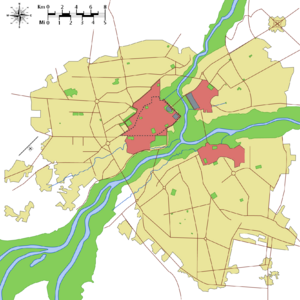Difference between revisions of "Samadar"
m (→Cityscape) |
|||
| Line 133: | Line 133: | ||
==Cityscape== | ==Cityscape== | ||
===Architecture=== | |||
===City walls=== | |||
===Catacombs=== | |||
===Canals=== | |||
===Koman gardens=== | |||
==Culture== | ==Culture== | ||
Revision as of 17:08, 23 April 2023
Samadar
. SAMADAR . | |
|---|---|
Metropolis | |
 Clockwise from top: View of western Samadar at the feet of the Jəhmara, Bashar gardens, bird view of the Hokshah fortress, Nadjakhar square, Tamgha Gharam, neo-traditional skyscrapers. | |
| Nickname(s): | |
 | |
| Country | |
| State | |
| Province | |
| Earliest settlement | c. 3000 BCE |
| Government | |
| • Mayor | Satar Khamanli |
| Area | |
| • Total | 2,300.61 km2 (888.27 sq mi) |
| Elevation | 800 m (2,600 ft) |
| Population (2016 census) | |
| • Total | 5,823,399 |
| • Density | 4,850.36/km2 (12,562.4/sq mi) |
| Demonym(s) | Samadari, Samadawár |
| Time zone | SCT+3 |
| Website | www.Samadar.km |
Samadar (Koman: Samadar) also known as Masandar or Samasar is one of the historical capitals of the Great Horde and officially recognised as the cultural centre of Komania, it is located in northwestern Komania with a population of around 5,800,000 people. The city is strategically located in a fertile valley which has served as the refuge for many cultures and civilisations throughout history. Situated in a plateau of around 800 metres above sea level, the city is 500 km west of Shanvan and serves as the capital of Saraj.
Etymology
History
The exact date for the establishment of the first settlements in Samadar is unknown, however, excavations in the area pinpoint an increment of human activity around 4000 BCE. Thanks to its strategic position in the Şəhmara valley the area offers largely defensible channels while covering a moderately fertile area. Excavations in the present-day Husah quarter have yielded a wealth of archeological evidence, among the most significant finds are pottery shards, bronze tools, and other artifacts that suggest the city was a center of trade and commerce, even as early as pre-Mamikian times.
Research in the 1960s has suggested a possible link between early settlers and the Sasna Culture of northern Vaniua, shedding light on possible migratory patterns between the proto-Vaniuan peoples of the basin and those living on the northern plains. Despite the amount of evidence, however, early settlements in the area appear to have been seasonal, indicating that early settlers were likely seasonal nomads. This rules in contrast with archeological findings on the coast of the Melkanchuta Sea, where remains from 2000 BCE and onwards seem to have been sedentary in nature. The drier Ghiro plains surrounding the basin present substantial evidence for transitional cultures, in which differences in pottery material might represent a cultural split between the more nomadic proto-Vaniuans and the more sedentary coastal cultures found around the Melkanchuta Sea.
Antiquity
Capital of the Vataman Khanate
The present-day Husah quarter of Samadar once belonged to a larger network of Ohanian trading outposts and served as a major hub for merchants before the 3rd century CE. The area was subsequently appropriated by the Mishars, who used the remaining settlement and its location to their favor. By the 8th, Samadar (then known as Masatar) had become the largest city in the region, serving as the capital of the Mishar Vataman Khanate, presenting itself as a prominent administrative center.
Şəhmara (known by then as Jôhmar) were the Mishars established several long-lasting kingdoms throughout the following centuries.
Kothlenic era
Rise of the Qomandi
Asharid era
Warring period and Koman state eras
Districts
Historical district
Federal Quarter
The Federal Quarter, comprising the headquarters and federal establishments of the Central Federation, is directly located within the Imperial Citadel, formally part of the Historical District of Samadar, it includes the Palace of the Federation, which was historically used as a prominent eastern wing of the Khashawan Palace, former residence of Great Horde emperors and rulers of the Samadar Mizarate. This section of the palace was repurposed in 1987 shortly after the establishment of the Central Federation, whereas Samadar was chosen as the indicated city to become the executive centre of the newly born federation. Restoration of the palace followed strict architectural protocols of the 80s, respecting the integrity of the building and any historical markers noted in its architecture, prominently, using original material from its construction back in the 1400s by importing red stone from Baghazan and ceramic tiles from Vogia. Only 20% to 40% of its interior was demolished and redone for logistical and practical purposes, this included the main hall and the upper floors, which exhibit Classical Hozaran architecture, and where strong classical Ohanian influences can observed. The Palace of the Federation currently holds the Grand Assembly, the Federal Commission building, whilst the State Council is located separately from the main palace.